#Infectious diseases
Text
Premiering today at 12 pm ET: the first ever Crash Course Lecture! Join us and guest lecturer John Green in the live chat as we learn about the history and science of #tuberculosis and how we can #StopTB
Crash Course Lectures are individual long-form videos that dive deep into a topic in a multidisciplinary way. As always at Crash Course, we embrace curiosity. We hope learners of all kinds enjoy these lectures, and that you are inspired to continue learning about the topic even after the video ends!
1K notes
·
View notes
Text
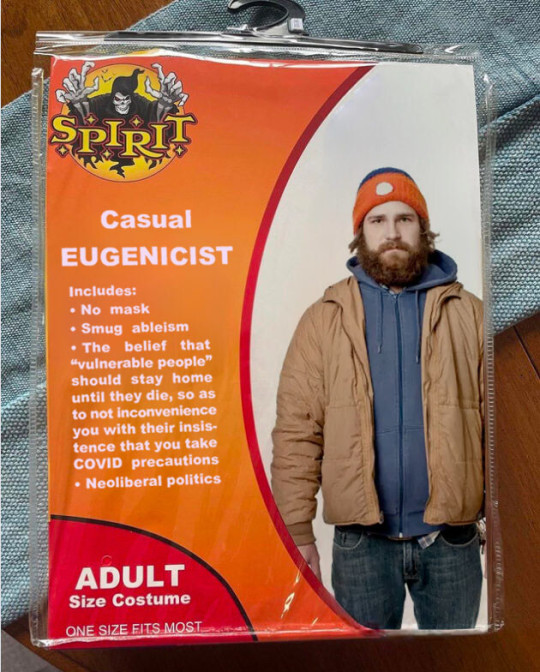
Most of you are going as this for Halloween. And it doesn't even require a costume.
https://www.reddit.com/r/HermanCainAward/
#COVID #COVIDisNotOver #COVIDisAirborne #COVID19 #eugenics #ableism
#happy halloweeeeeeen#halloween#long covid#covid19#covid 19#covid isn't over#covid#coronavirus#corona virus#health#occupationalhealthandsafety#plaguecore#plague mask#plague doctor#a plague tale#plaguetober#plague#viruses#virus#infectious diseases#infection#eugenics#eugenicist#ausgov#politas#auspol#tasgov#taspol#australia#fuck neoliberals
203 notes
·
View notes
Link
Cancer
“Starting at home, a study last year found that US cancer deaths had declined by 33% since 1991. This is equivalent to around 3.8 million people alive thanks to various efforts to combat the disease family.
The report was authored by the American Cancer Society, and published in the journal CA. American Cancer Society CEO Karen Knudsen called the drop “truly formidable,” while the report attributed the fall to the development of better treatments, the reduction in smoking habits, and earlier detection methods.
Just between 2019 and 2020, cancer death rates dropped 1.5%, while the deployment of the HPV vaccine was correlated with a 65% drop in cervical cancer rates from 2012 through 2019 among women in their 30s.
The report also found that not only are death rates falling, but 5-year survival rates for detected cancers have increased 68% among all diagnoses made between 2012 and 2018.
Guinea Worm Disease
Cancer research often involves cutting edge medical research, but across West Africa and India where cutting edge medicine is not widely available, human determination has succeeded in nearly eradicating Guinea Worm disease.
There are records of this truly unpleasant parasite affecting human health going back thousands of years, and in 1989, there were nearly 1 million cases globally.
But in 2022, this unwelcome waterborne guest created just 15 cases worldwide—a decline of 99.998%, and almost all 15 of those cases occurred in Chad.
This monumental turnaround was not the result of some experimental vaccine, but simple education, teaching people how to avoid drinking contaminated water, when and where this mostly seasonal parasite is likely to be found, and how to treat water to purify it of the Guinea worm.
Ebola
Other than Chad, Guinea Worm disease was also found in Uganda, which produced another medical milestone with the successful eradication of a recent Ebola outbreak.
The outbreak began in September, driven on by the incurable Sudan strain of the virus. It was the worst outbreak in 20 years, but even though there is no vaccine for the Sudan strain, the health authorities managed to contain it to just two administrative districts, and 142 confirmed cases.
“The magic bullet has been our communities who understood the importance of doing what was needed to end the outbreak, and took action,” said health minister Dr. Jane Ruth Aceng Ocero last Wednesday.
Vaccine trials involving Oxford University are currently underway for the Sudan strain, but until that time, health authorities received congratulations for their swift actions, and were thanked for the “lessons learned.””
-via Good News Network, 1/19/23
#united states#africa#chad#uganda#cancer#cw cancer#infectious diseases#parasite#ebola#sudan#west africa#india#healthcare#disease prevention#global health#good news#hope
734 notes
·
View notes
Text
Q Fever
Aka, Query fever. What a weird name for a disease. Imagine telling people that's what you got.

in the 30s-40s, an Australian pathologist in QLD/Brisbane, came across an outbreak of the same or similar illness among abbatoir or slaughterhouse workers.
At the time, he called the disease "Q" fever or query as a temporary name until the pathogen could be identified. Unfortunately it stuck.
decades later, now nobel prize winner and virologist, MacFarlane Burnett isolated and identified the microbe responsible. I think this discovery contributed to his prize. i forget already.
Microbe responsible: Coxiella burnetti. Named for Burnett and HR Cox, the American bacteriologist who found the genus Coxiella where C burnetti falls under.
Initially they felt it was related to Rickettsia, responsible for Rocky Mountain Spotted Fever, but as science progressed, this was disproven.
Now for a Case Report
A 55 yo Italian man with a history of aortic valve replacement was diagnosed with pyrexia of unknown origin twice. Further signs included myalgias/splenomegaly/night sweats. The 2nd time he was admitted for PUO he deteriorated rather dramatically and was put on meropenem and teicoplanin.
A host of organisms was tested for on serological testing based on the man's travel and epidemiological history, all negative. Even a rheumatological panel was done, also less revealing. He also had a history of MGUS (a haem disoder), which is kind of a red herring here.
Cultures were negative, no vegetations were seen on a TTE - so they did consider IE. Which is an important differential for PUO.
Eventually a PET-CT was done (often favoured when investigations do not yield much for a sick patient with fevers), finally revealing a focus of infectious on his ascending aorta, where he'd also had previous surgery done. And in a round about way, they also further identified Coxiella Burnetti. He was treated doxycycline and hydroxychloroquine. As it's so rare in Italy, it wasn't really considered even though he mentioned rural travel.
Bottomline: Q Fever is an important consideration in the work up for culture negative IE. Further to this, always consider IE in the differentials for PUO particularly if they're at increased risk for IE (prosthetic valves, damaged valves, select congenital heart issues, previous IE). IE can present with night sweats, fevers, weight loss and splenomegaly. It can be insidious and chronic in nature. other risk factors can be more suggestive as we'll get into below.
Causative organism
Coxiella burnetti, it's a zoonoses - i.e. transmissible from animals. Special powers: very tough/hardy, can survive extreme environments (high temps and UV light etc.) over prolonged periods and is resistant to many common disinfectants/surface cleaners.
It's an intracellular pathogen and gram negative coccobacilli (PINK!)
name coccobaccili reminds me of cocopuffs.

it's mainly associated with farm animals, which the CDC so wholesomely displays on its website on Q fever (wtf).
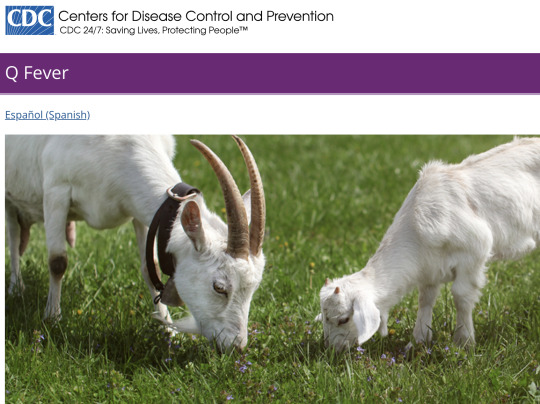
goats, sheep, cattle typically (but many other animals, even birds, dogs and horses can be reservoirs)
in particular bodily fluids - amniotic fluid, placenta, faeces/urine, milk etc.
you can get it through unpasteurized milk and through inhaling it if it lands on dust in the area
ever visit a farm or petting zoo lately? OMG WASH YOU HANDS.

That said, it's typically inhaled in inorganic dust. You inhale it, it goes to the lungs, and then the bloodstream.
Increased risk for Coxiella burnetti (What to take on history of exposures and when to strongly consider it)
live on a farm or near one
exposure to a farm
work as a vet on a farm
farm worker, dairy workers, researchers on these animals/facilities
slaughterhouse/abbatoir
Also from CDC:

Clinical presentation
Most won't get sick after exposure and remain asymptomatic, a very small minority does. even though it is highly infectious.
incubation time is 2-3 weeks (consider this time in your history of exposure, did they work on the farm 2-3 weeks ago as opposed to yesterday).
Nonspecific acute infectious symptoms:
nonspecific systemic fevers/malaise/arthralgias/myalgias--> key is high fevers though and can be associated with headache and photophobia.
non specific GI - N/V/diarrhoea
respiratory ones - SOB or cough, consider it as atypical cause of community acquired pneumonia.
rare: hepatitis and jaundice (granulomatous) or encephalitis with neurological complications such as demyelinating disease or CN palsies, also haemolytic anaemia and HLH (yikes)

really it's the history of exposure that will lead you down the garden path to Q fever.
Chronic Q fever is perhaps worse, and can present as culture negative IE/PUO. Months/years later, as B symptoms as above above + LOW/LOA, night sweats. More likely to occur if you are predisposed for IE as above, have a weakened immune system for any reason, including pregnancy.
Chronic Q fever has a mortality of 10% if left untreated. About <5% of those with acute Q fever develop this if left untreated. Speculation is that it's more of an autoimmune process or abnormal immunological response to the bacteria.
To be honest, most who walk in the door with community acquired pneumonia get treated empirically for atypicals anyway, (standard course of doxycycline), so we hardly really ponder the question of Q fever in every patient. But if they present chronically and did not have atypical cover at the onset of acute symptoms, then it's something important to consider.
Other important conditions - can cause complications in pregnant women and 20% will get post Q fever syndrome. like chronic fatigue.
investigations
Serology! nice and easy. Look for IgG antibodies in the chronic presentation. Or PCR. Down side to serology - can take 2-3 days for the body to make said antibodies to the bacteria for detection. PCR can be done on any fluids/tissue sent.

Cultures useless, hence it fall under the umbrella of culture negative (hard to grow outside a host cell, it is an obligate intracellular pathogen).
Other hints on bloods (as serology/PCR takes time to return) - elevated or low platelet's, transaminitis with normal bili, opacities in CXR with hilar lymphadenopathy, CSF will show raised protein levels if done when encephalitis is suspected.
imaging can also support the diagnosis.. as illustrated by the case report.
Treatment
Acute disease - as standard for atypical bugs, doxycycline 100 mg BD for 14 days. Alternatives - TMP SMX or Clarithromycin.
Chronic Q fever or IE:
native valves: doxycycline and hydroxychloroquine (200 TDS) for 18 months
prosthetic: same but 24 months
why hydroxy: enhances the action of doxycycline (increases the pH of the phagolysosome)
Follow-up: look for 4 fold decrease in IGG
Sources:
CDC
Stat Pearls
Wiki as linked above
#australian history#medblr#medblrs#infectious disease#infectious diseases#q fever#coxiella#coxiella burnetti
66 notes
·
View notes
Text
I put together a couple “Signs & Symptoms” info images for Infected Home-verse :)
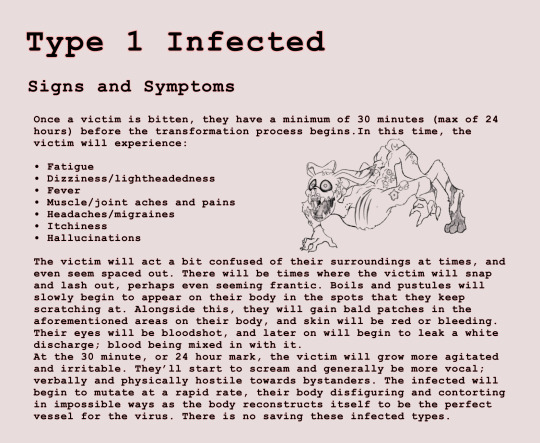
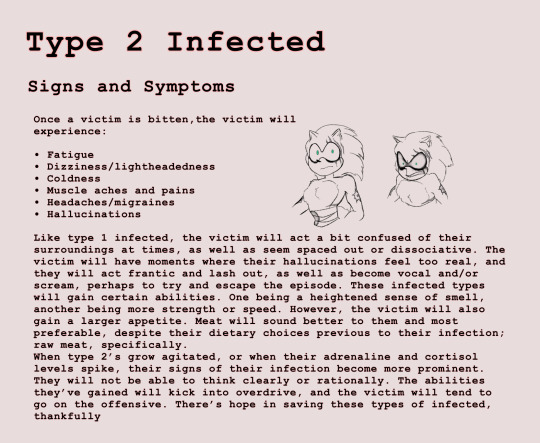
Edit: I seem to forgotten a very obvious sign! Since the body is still given ‘orders’ to mutate in Type 2’s, the body is most likely to respond in height change; something less drastic than what Type 1’s go through.
Check below for the separate sketches:

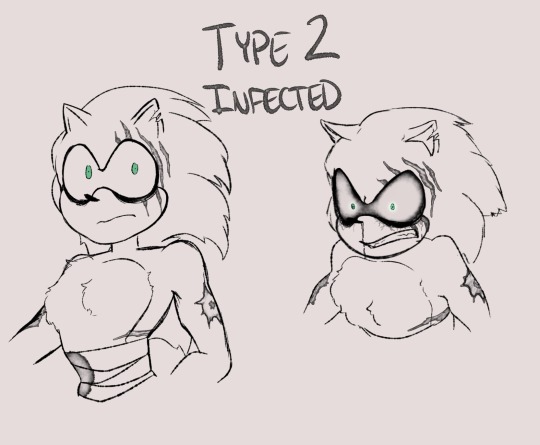
#my art#artists on tumblr#digital art#yippie!!!#sonic#sonic au#sonic the hedgehog#artwork#augh#infected home verse sonic#infected home verse au#infection#infectious diseases#infected sonic#sonic fandom#sonic fan au#sonic sketch#infected sketch#zombie#apocalypse#apocalyptic#au#information#infection info#tw blo0d#tw body horror
50 notes
·
View notes
Link
The emergence of mRNA vaccine technology represents a monumental leap forward in disease prevention. A review article published in Nature Reviews Drug Discovery by researchers at the University of Pennsylvania and Carnegie Mellon University discusses the evolution of messenger RNA (mRNA) based vaccines over the course of the past few years. The powerful effects of mRNA vaccines were exhibited during the COVID-19 pandemic in 2020. These vaccines were one of the most widely produced and administered vaccines across the globe to combat the SARS-CoV-2 retrovirus that was spreading rapidly at the time, and are the most popular known example of mRNA vaccines. The review emphasizes the potential mRNA vaccines hold for viruses beyond the one that caused the 2020 pandemic, along with alternative delivery modes to viral modes, such as those based on lipid particles.
The administration of vaccines is a necessity to tackle life-threatening diseases as well as to increase the average lifespan of the general population. They reduce fatality rates usually caused by highly infectious diseases like polio, smallpox, influenza, and tetanus. They provide us with protection against these diseases by inducing the generation of antibodies that are specific to the pathogen present in the human body, enabling the individual’s body to fight the disease when it strikes in the future.
Traditional vaccines have failed to deal with pathogens like human immunodeficiency viruses (HIV, the causative organism for AIDS), Plasmodium falciparum (the parasite that causes malaria), and hepatitis C. Vaccinations for influenza require regular upgrades and modifications due to the rapidly evolving nature of the genome of the influenza virus.
Continue Reading
71 notes
·
View notes
Text
Velvet and Veneer One-Shot
“I Couldn’t Save You” Prelude: Day 1
Day 1: Rageous Detention Center for Troubled Youth
Velvet sat filing her nails. Laying next to her, Veneer was reading a few comic books they had allowed him for good behavior.
They were in the mess hall when they had called for a mandatory cell isolation…. Velvet and Veneer so happened to share a cell. It had been five hours and no one has come to say anything.
“How long do we have to be in here?” Velvet moaned.
“Just hang in there Vels. Sheesh. You don’t always have to be a drama queen y’know.” Veneer exclaimed. She slapped the comic books away from his hands and into to the floor.
“Hey!” He exclaimed.
“Oops.” She smirked. At that moment two guards showed up at their cell door.
“Screening time.” They said. The twins looked at each other confused. Screening? They did their screening before they even entered this hell hole. But they didn’t refuse. One guard took Velvet by the arm while the other took her brother.
“Wait?” She questioned. They stayed together… they ALWAYS stayed together.
“Sorry. This screening needs to be done separately. The guards led them away in opposite directions. Veneer turned back and gave her a reassuring smile….. what the heck is going on?
The screening only required them to take a sample of her blood. Upon quick testing the word “CLEAN” appeared on the screen. Velvet asked questions… but there was no response. Within the hour, she was led back to her cell. She could smell that it had been disinfected and cleaned while she was out…She looked around…Where was Veneer?
A whole other hour passed. During that time Velvet notices the teens in cells being switched out and moved….doctors and workers walking by with medical masks….What the heck is going on? Velvet thought to herself. She kept asking any worker that passed where was her brother, but all ignored her..
She was sitting on her bed, head leaning against the wall when she heard footsteps approaching. That’s when she turned and saw Veneer being escorted….escorted to the cell opposite her.
“Hey what gives!” She ran up to the tempered glass. They gave Veneer a gentle shove into the cell; he looked at Velvet, confused and lost.
“Vels? What’s going on?” He asked her, placing his hands against the tempered glass. The doctors ignored his question only to continue to murmur amongst themselves. Velvet was able to catch a few words…quarantine, symptoms, monitor, how long.
“It’s spreading quick…” She could hear someone say. “Quarantine the infected….We don’t know what to look for in our species as the virus progresses…”
Virus?
“Hello! Can someone explain to us what you’re doing! Why is my brother in the opposite cell? We haven’t even done anything wrong? And I can handle a common cold!” Velvet yelled. The doctors hovered by Veneers cell for a moment longer, talking and writing something down.
“Hey, jerk face! I’m talking to you…what’s going -“ Velvet stopped short….when the doctors moved away she saw what they had been doing…what they had been writing….Next to Veneer’s cell was posted paperwork, and in big red writing: INFECTED. She looked at her brother with worried eyes. He looked at her quizzically.
“Vels, are you okay? Really, like, what’s happening here?….I’m slowly starting to freak out.” He asked….he had no clue? They didn’t tell him? Was it serious enough that they had to isolate him from her? At that moment one female doctor turned to look at her. Walking up to her cell, she placed her hand against the tempered glass….
“I’m so sorry sweetheart.” The doctor said softly. With that she was gone, leaving the twins to themselves.
“Wait! Wait come back! Please tell me what’s going on! Please tell me my brother is going to be okay!” She screamed after them. Veneer looked at her with a worried expression, he couldn’t see what the doctors had written and placed by his cell.
“Vels?” He said. Velvet leaned her head against the tempered glass. She looked up at him…he looked fine…he still looked like his normal self…so that means…he was going to be okay….Yes, yes, he was going to be fine…she had to believe it.
“Whatever this is…we’ll get through this okay.” She tried smiling….little did she know though…from that point on…was just a ticking time bomb…
#velvet and veneer#velvet#veneer#trolls veneer#velvet trolls#velvet and veneer trolls#dreamworks trolls#trolls band together#trolls 3#fandom#fanfiction#fanfic#oneshot#au#infectious diseases
49 notes
·
View notes
Text
“If you have to prescribe imipenem, do it. But with good reason, otherwise you’ll summon an infectious disease doctor that’ll slap you in your sleep.”
22 notes
·
View notes
Text
I’m watching killers and someone died of a preventable disease and I was reminded yet again of how much I despise anarcho primitivists and anyone who describes themselves as even remotely “anti-society”. They have reached a level of delusional that is extremely dangerous and if I had any kind of political power I would regularly launch public awareness campaigns about how any advocating that life was “better” hundreds of years ago (especially if they want to destroy modern infrastructure in order to get to “better”) is pathologically anti-human. I hate it and I think if you believe those things you are more naïve than I can personally help.
this is your personal reminder that technology and science are not bad things-the social organization of society is bad. The rejection of any kind of medicine that isn’t directly profitable is bad. And the development of science and technology is a good thing that left wing governments should seek to continue and expand-making their benefits available to all people (not just the rich). No human benefit is gained by destroying our medical system and blowing people back to the dark ages. Yes, traditional herbal medicine is great for a lot of chronic and stress related diseases/natural aging but it won’t save your kid from whopping cough, your dad from cancer once it’s developed or put you back together once you’ve been in a major accident and I hate HATE that American society is so braindead that we can’t just accept both realities without unscientifically rejecting all the incredible benefits of modern life.
#imagine thinking it would be wise to go back to a time#when 40% of children died before 15#yes#by accidents#starvation#infectious diseases#or genetic diseases#or wounds that couldn’t be fixed
29 notes
·
View notes
Text

"...Ready the Necrotising Fasciitis..."
#nurgle#nurglings#surgeon#surgery#infectious diseases#infection#operating room#operating theatre#healthcare#helth#treatment#warhammer chaos#warhammer fanart#fanart#warhammer 40k#warhammer 40000#wh40k#artists on tumblr#support human artists
56 notes
·
View notes
Text
With Arctic permafrost thawing, Pentagon frets over deadly pathogens
22 notes
·
View notes
Text


9/19/2023
Pics from a recent used bookstore expedition + my lil buddy who i miss dearly (he is now comfy at home with his owner who is back from their trip).
Started my pediatric Infectious Disease rotation this week and I am enjoying myself immensely so far. I'm already learning a lot and seeing very interesting pathology. Plus, it's a treat to wake up after 5 am, and I don't have to work weekends, either.
#emgoesmed#studyblr#studyspo#med student#med school#med studyblr#ms4#productivity#bookstore#cat#pet#infectious diseases#pediatrics#i miss my little guy#except for when he would try to trample all over my stomach/chest at 5am because he was hungry#the house does feel more peaceful now that it's just me#but i'm catsitting again next week#so it's only a temporary peace#it will be a different cat#i'm looking forward to it#:)
37 notes
·
View notes
Photo

Cognitive impairment from severe COVID-19 equivalent to 20 years of ageing
Cognitive impairment as a result of severe COVID-19 is similar to that sustained between 50 and 70 years of age and is the equivalent to losing 10 IQ points, say a team of scientists from the University of Cambridge and Imperial College London.
The findings, published in the journal eClinicalMedicine, emerge from the NIHR COVID-19 BioResource. The results of the study suggest the effects are still detectable more than six months after the acute illness, and that any recovery is at best gradual.
There is growing evidence that COVID-19 can cause lasting cognitive and mental health problems, with recovered patients reporting symptoms including fatigue, ‘brain fog’, problems recalling words, sleep disturbances, anxiety and even post-traumatic stress disorder (PTSD) months after infection. In the UK, a study found that around one in seven individuals surveyed reported having symptoms that included cognitive difficulties 12 weeks after a positive COVID-19 test.
While even mild cases can lead to persistent cognitive symptoms, between a third and three-quarters of hospitalised patients report still suffering cognitive symptoms three to six months later.
To explore this link in greater detail, researchers analysed data from 46 individuals who received in-hospital care, on the ward or intensive care unit, for COVID-19 at Addenbrooke’s Hospital, part of Cambridge University Hospitals NHS Foundation Trust. 16 patients were put on mechanical ventilation during their stay in hospital. All the patients were admitted between March and July 2020 and were recruited to the NIHR COVID-19 BioResource.
The individuals underwent detailed computerised cognitive tests an average of six months after their acute illness using the Cognitron platform, which measures different aspects of mental faculties such as memory, attention and reasoning. Scales measuring anxiety, depression and post-traumatic stress disorder were also assessed. Their data were compared against matched controls.
This is the first time that such rigorous assessment and comparison has been carried out in relation to the after effects of severe COVID-19.
COVID-19 survivors were less accurate and with slower response times than the matched control population – and these deficits were still detectable when the patients were following up six months later. The effects were strongest for those who required mechanical ventilation. By comparing the patients to 66,008 members of the general public, the researchers estimate that the magnitude of cognitive loss is similar on average to that sustained with 20 years ageing, between 50 and 70 years of age, and that this is equivalent to losing 10 IQ points.
Survivors scored particularly poorly on tasks such as verbal analogical reasoning, a finding that supports the commonly-reported problem of difficulty finding words. They also showed slower processing speeds, which aligns with previous observations post COVID-19 of decreased brain glucose consumption within the frontoparietal network of the brain, responsible for attention, complex problem-solving and working memory, among other functions.
Professor David Menon from the Division of Anaesthesia at the University of Cambridge, the study’s senior author, said: “Cognitive impairment is common to a wide range of neurological disorders, including dementia, and even routine ageing, but the patterns we saw – the cognitive 'fingerprint' of COVID-19 – was distinct from all of these.”
While it is now well established that people who have recovered from severe COVID-19 illness can have a broad spectrum of symptoms of poor mental health – depression, anxiety, post-traumatic stress, low motivation, fatigue, low mood, and disturbed sleep – the team found that acute illness severity was better at predicting the cognitive deficits.
The patients’ scores and reaction times began to improve over time, but the researchers say that any recovery in cognitive faculties was at best gradual and likely to be influenced by a number of factors including illness severity and its neurological or psychological impacts.
Professor Menon added: “We followed some patients up as late as ten months after their acute infection, so were able to see a very slow improvement. While this was not statistically significant, it is at least heading in the right direction, but it is very possible that some of these individuals will never fully recover.”
There are several factors that could cause the cognitive deficits, say the researchers. Direct viral infection is possible, but unlikely to be a major cause; instead, it is more likely that a combination of factors contribute, including inadequate oxygen or blood supply to the brain, blockage of large or small blood vessels due to clotting, and microscopic bleeds. However, emerging evidence suggests that the most important mechanism may be damage caused by the body’s own inflammatory response and immune system.
While this study looked at hospitalised cases, the team say that even those patients not sick enough to be admitted may also have tell-tale signs of mild impairment.
Professor Adam Hampshire from the Department of Brain Sciences at Imperial College London, the study’s first author, said: “Around 40,000 people have been through intensive care with COVID-19 in England alone and many more will have been very sick, but not admitted to hospital. This means there is a large number of people out there still experiencing problems with cognition many months later. We urgently need to look at what can be done to help these people.”
Reference; Hampshire, A et al. Multivariate profile and acute-phase correlates of cognitive deficits in a COVID-19 hospitalised cohort. eClinicalMedicine; 28 Apr 2022; DOI: 10.1016/j.eclinm.2022.101417
Source: University of Cambridge. Image: GettyImages.
405 notes
·
View notes
Text
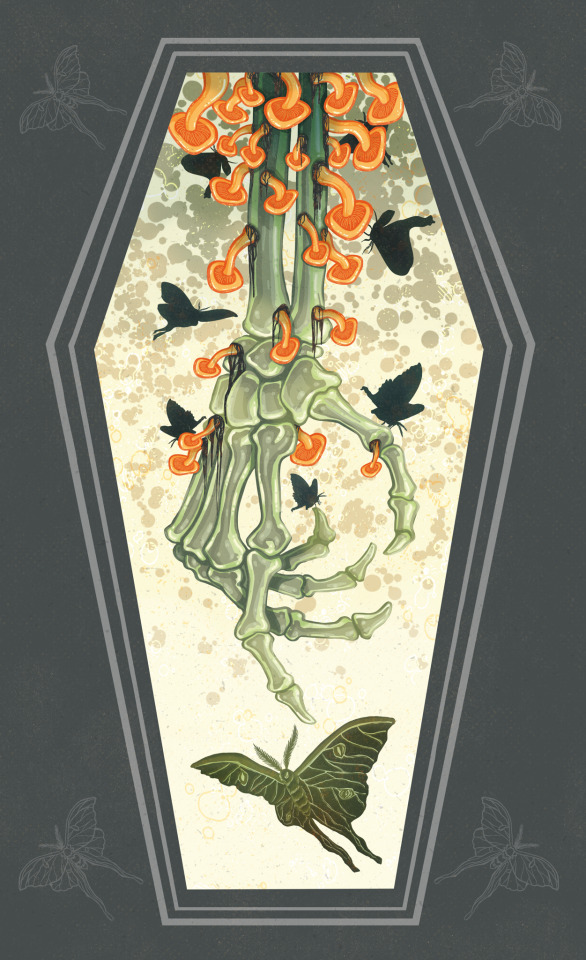


The triptych put together.
Contagion / Breathe Easy / Memento (Mori)
Adobe Fresco + Photoshop
#art#illustration#artists on tumblr#meganfrau#drawing#megan frau#adobe fresco#digital art#infectious diseases#death#isolation#moths#skeletons#masks#coffins#flowers#pearls#mourning#grief
112 notes
·
View notes
Text
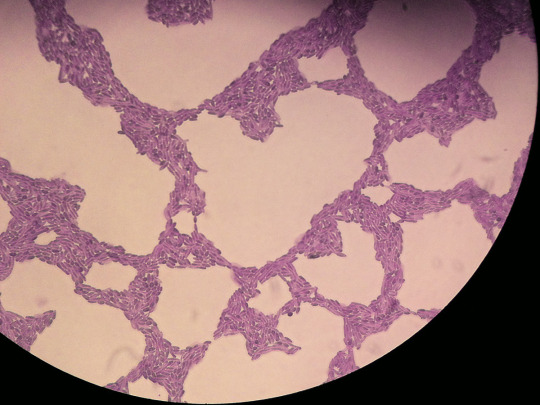
Rhodotorula
“Rhodotorula mucilaginosa cells, methylene blue stain, magnification 400 x, notice the oval yeast cells as well as filamentous structures (pseudohyphae).” - via Wikimedia Commons
#fungi#fungus#microbiology#wikipedia#wikipedia pictures#wikimedia commons#nature#microbes#mycology#medical mycology#medical#medical microbiology#infectious diseases#medicine#methylene blue#methylene blue stain#specimen staining#fungal infection#fungicore#mycologycore#microscope#microscopy#yeast
8 notes
·
View notes
Link
Infectious diseases have been a persistent challenge to public health despite significant advancements in various scientific disciplines. The emergence of viruses resistant to drugs, the frequency of pathogen outbreaks, and the ongoing danger of pandemics underline the urgent need for new and effective treatments. Addressing these challenges requires the combined efforts of multiple disciplines, and recent artificial intelligence (AI) discoveries are proving to be game-changing. Systems biology, synthetic biology, and AI are opening the path for quick advancements in the fight against infectious diseases.
Drug-resistant microorganisms have caused anti-infective drug effectiveness to decline, highlighting the urgent need for cutting-edge therapies. AI, particularly machine learning (ML), has played a crucial role in facilitating the search for new drugs and repurposing existing ones. ML has been instrumental in virtually screening vast compound libraries, which would be impossible through traditional empirical methods. Additionally, AI integration has been particularly beneficial in the context of infectious diseases due to their phenotype-driven nature and the biological tractability of the pathogens involved.
Continue Reading
#bioinformatics#infectious diseases#artificial intelligence#machine learning#pandemic#amr#mdr#drug resistance
47 notes
·
View notes